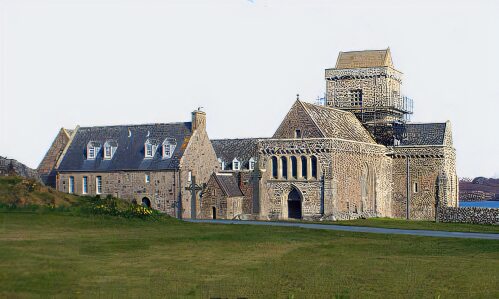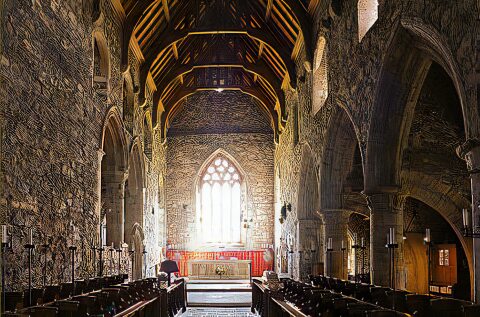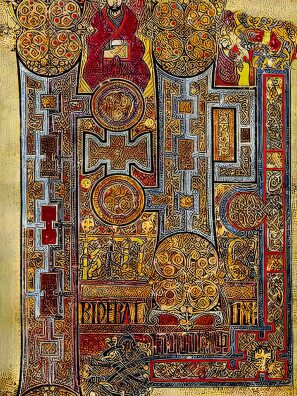Scotland
Iona Abbey, one of Scotland's most sacred sites and the symbolic centre of Scottish Christianity was the mausoleum of many of the early Scottish Kings.
Situated on the Isle of Iona on the West Coast of Scotland, the abbey is one of the oldest and most important religious centres in Western Europe. The abbey was a focal point for the spread of Christianity throughout Scotland and marks the foundation of a monastic community by St. Columba when Iona formed part of the Kingdom of Dál Riata.
Iona Abbey
An inventory of 1549 recorded 48 kings buried there in total, from Kenneth MacAlpin to MacBeth, made famous by Shakespeare, and his victim, Duncan, all made their final journey there, across the sound to Iona, onto the harbour, and up the Street of the Dead to the burial ground. The tradition of royal burial at Iona was broken only twice, firstly by Constantine II, who was buried St Andrews and secondly by Malcolm Canmore who lies at Dunfermline.
The last king to be buried on Iona was Malcolm III's brother, Donald Bane, before Malcolm's son, King Edgar, surrendered the island to Magnus, King of Norway in 1098 AD.
There are also kings from Ireland, Norway and France, buried in the Reilig Odhráin, (Oran's "burial place), the graveyard beside Sràid Nam Marbh, 'the street of the dead', one of the finest medieval paved roads in Europe, extending from Martyr&rsquo's Bay to the abbey. The island is also the final resting place of various Lords of the Isles and other prominent members of West Highland clans, including several early MacLeod chiefs. Saint Baithin and Saint Failbhe may also be buried in Iona. The inscriptions are said to have worn away by the end of the seventeenth century, early Christian and medieval monuments have been removed for preservation to the cloister arcade of the Abbey, and the Abbey museum (in the medieval infirmary). Recently the tradition was revived, and when the Labour leader, John Smith, a regular visitor to the island, was buried there.
Iona Abbey Interior
Several high crosses are located on the Isle of Iona, including St Martin's Cross, which dates back to the eighth century, the finest of Iona's Celtic high crosses, it is remarkably complete, adorned with a Pictish serpent-and-boss decoration on one side and holy figures on the other.
A replica of St John's Cross is situated by the doorway of the Abbey. The restored original stands in the Infirmary Museum at the rear of the abbey. The carvings on St. Martin's Cross are badly weathered, but the figurative scenes can be identified as the Virgin and Child, Daniel in the lions' den, Abraham and Isaac, David with musicians, and an uncertain scene that may depict Samuel about to anoint David.
St Columba (Calum Cille), sailed to Iona from Ireland in 563 with twelve companions, in a hide-covered boat, landing at the south end of the island, then known as the Isle of Druids. He founded the monastery which was to become a centre for the spread of Christianity among the Picts and Scots. The original monastery contained a timber church, surrounded by huts for the monks to live and work in, and small cells for prayer.
Columba was a useful asset to the Gaelic warrior kings. His monastery provided a place of education for their sons, he was a close advisor to the king, and he served as a diplomat to the king's neighbours in Pictland and Ireland. Columba died on the 9th June 597 and is said to have been buried below the small, stone chapel shrine, which is attached to the front of the abbey. Columba's tombstone was made from the stone on which he is said to have rested his head as he slept. A stone called 'St Columba's Pillow' was unearthed in 1870 by a crofter. The stone can now be seen in the Abbey museum.
The influence of Columba's monastery continued to grow, leading to the foundation of new monasteries in Ireland and as far away as Lindisfarne in Northumbria. In Pictland, Columban monks began to spread the word of Christianity in the seventh century. Pilgrimage to Iona increased, the kings of Scotland wished to be buried near Columba, and a network of Celtic high crosses and processional routes developed around his shrine.
The Book of Kells
The scriptorium of the abbey produced several highly important documents. At its zenith, the abbey produced the Book of Kells, a famous illuminated manuscript, described in the Annals of Ulster in 1007 as 'the most precious object in the western world', was written by the monks of Iona in the years leading up to 800.A.D. A masterpiece of Dark Age European art, the elaborately illuminated book containing the four Gospels was taken from Iona to Kells in Ireland and is now housed in Trinity College, Dublin. The Chronicle of Ireland was also produced at Iona.
The massacre of 68 monks in 806 in a Viking attack on Martyrs' Bay led Columba's monks to return to Ireland, others of the monks from Iona fled to the Continent, and established Monasteries in Belgium, France, and Switzerland.
In 825, St Blathmac and those monks who had returned with him to Iona, were slain by a further Viking raid, and the Abbey burned. St. Blathmac suffered martyrdom at the hands of the Vikings for refusing to divulge the treasures and relics of Columba.
In 849 AD Columba's relics were removed from Iona and divided between Scotland and Ireland. The parts of the relics which went to Ireland are reputed to be buried in Downpatrick, County Down.
The Monymusk Reliquary, from around 750 AD, probably contained a relic of St Columba and was preserved at Monymusk House. The small casket is house-shaped and decorated by an Insular fusion of Gaelic and Pictish design and Anglo-Saxon metalworking. The silver plates on the front and lid of the casket are decorated with beasts leaping and twisting and biting at their tails on a spotted field, characteristic of Celtic art style. It became a powerful symbol of nationhood and was carried before the Scots army as it marched into war. This reliquary is thought to be the Brechbennoch which was carried by the Scots at the Battle of Bannockburn in 1314, the Celtic name Brec-bennoch has been translated in Gaelic as both 'the blessed shrine' or 'the speckled, peaked one'. The reliquary is now housed in the National Museum of Scotland.
The abbey was probably not deserted. Its continued importance is revealed by the death there in 980 of Amlaíb Cuarán, a retired King of Dublin.
Iona was taken by the King of Norway, who held it for fifty years before Somerled 'King of the Hebrides' retook the island, Somerled's son Raghnall, 'Lord of the Isles', invited the Benedictine order to establish a new Monastery in 1203. Building work then began on the new Abbey church, which occupied the site of Columba's original church.
Tombstones of the early Scottish Kings at Iona
An early Augustinian Nunnery was established south of the Abbey buildings. Somerled's sister, Bethag, was its first prioress. It was known as Eaglais Dhubh or the black church because of the nuns' robes. The Nunnery buildings were rebuilt in the fifteenth century but fell into disrepair after the Reformation. The Abbey church was substantially expanded in the fifteenth century, but following the Scottish Reformation, Iona was abandoned.
The abbey church was restored at the beginning of the twentieth century. Little remains of Columba's original monastery, however, traces of the vallum, or ditch, that surrounded the monastic enclosure, are still visible. The oldest part of the abbey is the restored St Oran's Chapel, which lies to the south of the abbey, which was probably built by the Gaelic warlord Somerled, 'King of the Isles', as a family burial chapel, prior to his death in 1164. The building is plain and unadorned except for its eleventh century Norman doorway, decorated with chevron carvings.
The small building known as St Columba's Shrine is situated just outside the abbey church. It is mostly a restoration of 1962, but the lower courses may date from the mid-700s when St Columba's relics were buried there in 597.
Iona Abbey is now in the care of Historic Scotland, the abbey's museum is housed in a restored building that may once have been the monks' infirmary. On display are some of the best late-medieval West Highland grave slabs. Among the warrior, effigies are that commemorating Gilbride MacKinnon (died c.1280), who is depicted in armour. His shield is carved with the Hebridean birlinn (galley) and, beneath it, an otter pursuing a fish. Displayed around the cloister walls are 29 West Highland grave slabs. Most were brought indoors from Reilig Òdhrain for their better preservation after the restoration in 1958-9. In 1858, the Duke of Argyll had rearranged them in two rows within iron railings - 'the ridge of the kings', and 'the ridge of the chiefs'. They commemorate the clan chiefs, 'the best men of the Isles' - among them MacKinnon's, MacLeans and MacLeods.
